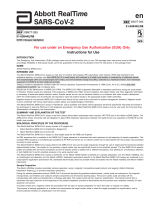Page is loading ...

ver.20221202E
Resonac Corporation (https://www.shodex.com/)
1
Operation Manual
Shodex STANDARD P-82
(Please read this manual carefully to achieve accurate and consistent molecular weight information for a long time)
Important Handling Instructions
Caution! · Please consult the Safety Data Sheet (SDS) of reagents and solvents used with the column
and understand their proper handling methods to prevent potential health hazards or death
from occurring.
· Please wear appropriate personal protective equipment such as lab goggles and gloves
when handling organic solvents and acid and alkaline reagents. Avoid any direct physical
contact to prevent chemical injuries.
Before Using the Standard
(1) Please visually inspect the package and outside of the reagent bottles for any damage.
(2) Please check if product name and lot number written on the package, reagent bottle adhesive labels, and
enclosed INSPECTION CERTIFICATE are matching and correct.
(3) Please download INSPECTION CERTIFICATE for the purchased product. INSPECTION CERTIFICATE can
be downloaded from Shodex website (https://www.shodex.com/download/). You will be asked to enter the
lot number.
1. Introduction
Thank you for purchasing the Shodex product. Shodex STANDARD P-82 is pullulan standards which are
neutral polysaccharides with a non-branched linear structure containing repeating α-1,6 linked maltotriose
molecules. They dissolve easily in water, and rarely associate nor crystallize. They also have narrow molecular
weight distributions and are less likely to adsorb to the column packing material. Therefore, the standards are
suitable for preparing calibration curves required in relative molecular weight distribution analyses by aqueous
size exclusion chromatography (SEC).
2. Structural Formula
3. Product Information
Product Code Product Name Contents Molecular Weight (Mp) Range
F8400000 STANDARD P-82 0.2 g x 8 kinds approx. 5,000 - 800,000
(Note) Molecular weights (Mp, Mw/Mn) of a standard kit may vary depending on production lot.

ver.20221202E
Resonac Corporation (https://www.shodex.com/)
2
4. How to Use Standards
4.1 Sample Solution Preparation
(1) Viscosity of high molecular weight compound is largely influenced by its molecular weight and concentration.
Samples with high viscosity cause peak broadening and elution delay, and this makes it difficult to obtain
their accurate molecular weight distributions. In general, the larger the molecular weight of the compound,
the higher its viscosity becomes. To suppress the influence from high viscosity, it is recommended to lower
the sample concentration. Please use the below table as a reference when preparing samples for molecular
weight distribution analyses.
Molecular Weight Range Optimal Concentration (w/v)
5,000 - 25,000 0.5 %
25,000 - 200,000 0.25 %
200,000 - 1,000,000 0.1 %
(2) Add solvent to standard and let it stand to swell. The time required for swelling and dissolution depends on
molecular weight of a standard. Lower-molecular-weight standards swell and dissolve in a few hours.
However, higher-molecular-weight standards require a longer time. Leave them in a refrigerator for half a
day to a day until they fully swell.
(3) Once standard is fully swollen, gently stir the sample solution to let it completely dissolve and homogenize.
(4) Filter the prepared sample solutions using disposable 0.45-μm filters.
(5) Sample solutions should be stored in a refrigerator (about 4 °C recommended) to prevent it from bacterial
growth. Before storing the sample, adjust the sample pH between 5 and 7.
(6) Use refrigerated sample solutions within 1 week.
Attention! · Ultra-sonication may cause shear degradation if used to dissolve standards, and thus not
recommended.
· Bacteria can decompose standard samples. Moreover, the presence of bacteria in samples
may damage the column if injected.
· The standards dissolved in sodium nitrate aqueous solution may decompose even when
stored in a refrigerator. Please prepare fresh sample solutions at each analysis if sodium
nitrate aqueous solution is used to dissolve the standards.
Note · Please refer below article for physical properties of pullulan solutions.
T. Kato, T. Okamoto, T. Tokuya, A. Takahashi. “Solution properties and chain flexibility of
pullulan in aqueous solution” Biopolymers 21(8), 1982, 1623-1633
4.2 Drying
Standards contain a small amount of water. Dry standards before sample solution preparation to obtain desired
concentrations with higher accuracy. Standards contain a small amount of water. If concentration with an exact
accuracy is required, dry the standard before sample solution preparation. Below are example drying methods.
P-5 to P-100: Vacuum dry at 90 °C for 6 hours or longer
P-200 to P-800: Leave in a desiccator containing phosphorus pentoxide
Attention! · Higher-molecular-weight standard samples (P-200 and higher) may partially decompose
when heated.
4.3 Calibration Curve
Analyze standard samples under the same analysis conditions as target samples. Prepare a calibration curve
for measuring molecular weight distribution using retention times of each standard sample and their peak top
molecular weight (Mp) values stated on the INSPECTION CERTIFICATE.
4.4 Detection
Pullulan has a very weak UV absorbance, thus a UV detectors is not suitable. Generally, a RI detector is used.

ver.20221202E
Resonac Corporation (https://www.shodex.com/)
3
5. Storage
Store undissolved standards in a desiccator or an airtight container and refrigerate (about 4 °C recommended).
Do not open reagent bottles immediately after taking out from the refrigerator. Wait opening until the bottle
temperature reaches the room temperature.
Attention! · Presence of bacteria or mold in the air and/or on equipment may cause decomposition of
polysaccharides.
· A sign of bacterial decomposition is discoloration. If such an abnormality was observed,
do not use the standard.
6. Expiration Date
Expiration date of an unopened standard is 2 years from the inspection date.
Note · The inspection date is stated on the INSPECTION CERTIFICATE.
Please refer to the Shodex website (https://www.shodex.com/) for product details and their applications. For
additional assistance, contact the distributor from whom you purchased the column or contact your regional
Shodex support office (https://www.shodex.com/en/support_office/list).
/



